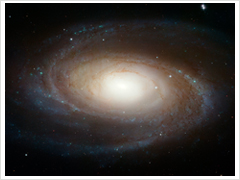 Copyright(c)www.hubblesite.org All Rights Reserved.
Copyright(c)www.hubblesite.org All Rights Reserved.
This photograph, taken by the Hubble Space Telescope, shows the spiral galaxy M81, which lies approximately 11.6 million light years away in the direction of Ursa Major. Based on the type of stars in its beautiful spiral structure, it is surmised that large-scale star birth began approximately 600 million years ago. Another galaxy, M82, is located near it, and it is believed that the two may have collided in the past.
 Copyright(c)www.hubblesite.org All Rights Reserved.
Copyright(c)www.hubblesite.org All Rights Reserved.This is a composite picture, in x-ray, visible light, and infrared light, of the galaxy cluster MS0735.6+7421, which lies approximately 2.6 billion light years away in the direction of constellation Camelopardalis. It is a superimposition of the image of the cluster taken by the Hubble Space Telescope, showing the various galaxies, an x-ray photograph colored in blue taken by the Chandra X-ray Observatory, and an infrared photograph taken by the Very Large Array telescope, colored in red. The blue part has gas heated up to a temperature of 50 million degrees.
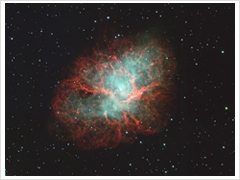 Copyright(c)www.subarutelescope.org All Rights Reserved.
Copyright(c)www.subarutelescope.org All Rights Reserved.This is an image of the Crab Nebula (M1) taken with the Prime Focus Camera on the Subaru Telescope. These supernova remnant, which is approximately 7,200 light years away and ten light years in diameter, was created by a supernova explosion that took place a millennium ago, in 1054. It was described, among others, by the poet Fujiwara no Teika in his diary, Meigetsuki. The exploded star remains in the center as a neutron star, which appears in radio and x-ray images as the gCrab pulsar.h
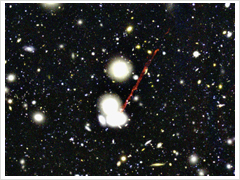 Copyright(c)www.subarutelescope.org All Rights Reserved.
Copyright(c)www.subarutelescope.org All Rights Reserved.The Prime Focus Camera of the Subaru Telescope revealed a mysterious hydrogen gas filament near the D100 galaxy in Coma Berenices. The filament of ionized hydrogen gas extends nearly 200,000 light years from the galaxy, which belongs to the Coma cluster, roughly 300 million light years from us. However, it is only 6,000 light years wide, and how this structure formed is a mystery.
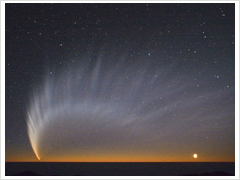 Copyright(c)www.eso.org All Rights Reserved.
Copyright(c)www.eso.org All Rights Reserved.Comet McNaught is seen in the night sky of the Southern Hemisphere. This comet, which was discovered by Robert McNaught in August 2006, reached perihelion in early 2007, and was so bright at that time, with a minus magnitude, that it could be seen in daylight. As it moved away from the sun, it trailed an impressive tail, as seen in this photo, and became a great comet in the evening sky of the Southern Hemisphere. Unfortunately, however, it couldnft be seen from Japan.
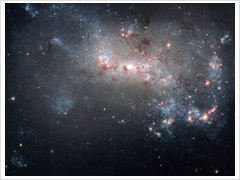 Copyright(c)www.hubblesite.org All Rights Reserved.
Copyright(c)www.hubblesite.org All Rights Reserved.An image of the dwarf galaxy NGC 4449, 12.5 million light-years away, taken by NASA's Hubble Space Telescope. Hot bluish-white clusters of massive stars are scattered throughout the galaxy, interspersed with numerous dustier, reddish regions of current star formation. This usually explosive and intense star formation activity qualifies as a starburst. At the current rate, the gas supply that feeds the stellar production will only last for another billion years or so.
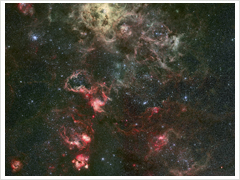 Copyright(c)www.hubblesite.org All Rights Reserved.
Copyright(c)www.hubblesite.org All Rights Reserved.The image of the Tarantula Nebula, also known as diffuse nebula NGC2070, located in the Large Magellanic Cloud of the southern sky. It is based on observations carried out with the Wide Field Imager (WFI) on the 2.2-m telescope at the La Silla Observatory in Chile. Located 170,000 light-years away from the earth, the Nebula measures more than 1000 light-years across. Its center harbours a cluster of hot young stars, emitting strong ultraviolet rays, which are reflected on the gas of hydrogen atoms and oxygen ions in the nebula and create beautiful colors.
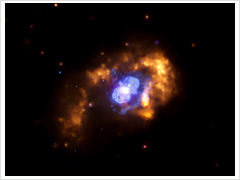 Copyright(c)www.hubblesite.org All Rights Reserved.
Copyright(c)www.hubblesite.org All Rights Reserved.Eta Carinae is located at a distance of about 7,500 light years from Earth. This is the latest composite image from NASA's Chandra X-ray Observatory (mostly red) and the Hubble Space Telescope (mostly blue). A star 150 times more massive than the Sun, Eta Carinae is near a point of unstable equilibrium where the star's gravity is almost balanced by the outward pressure of the intense radiation generated in the nuclear furnace. This means that slight perturbations of the star might cause enormous ejections of matter from its surface. About 150 years ago, Eta Carinae had a massive eruption, to briefly become the second brightest star in the sky, but the dust and gas that were thrown off by the star then now covers it and makes it invisible.
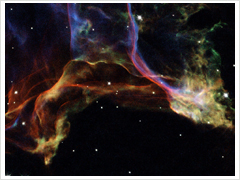 Copyright(c)www.hubblesite.org All Rights Reserved.
Copyright(c)www.hubblesite.org All Rights Reserved.Image of the Veil Nebula in the constellation Cygnus, as captured by the Hubble Space Telescope. This nebula is a supernova remnant located about 1,500 light years away. It was made by the supernova explosion. Interstellar material swept up by the blast wave creates shock fronts by which the nebula's radiant light is maintained. The entire structure is large, spanning 3 degrees in the sky, or about the size of six full moons.
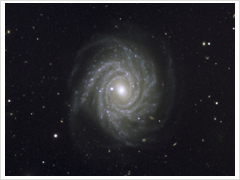 Copyright(c)www.eso.org All Rights Reserved.
Copyright(c)www.eso.org All Rights Reserved.Image of the beautiful spiral galaxy NGC 1288, as observed with ESO's 8m in diameter Very Large Telescope in Chile. It is thought to be 200 million light years distant. The supernova SN 2006dr, which exploded in July 2006, is visible to the left of the centre of the galaxy. This supernova is classified as a Type Ia supernova, and its blast speed reaches 10,000 km per second.
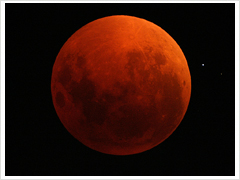 Copyright(c)Nayoro Kihara Astronomival Observatory All Rights Reserved.
Copyright(c)Nayoro Kihara Astronomival Observatory All Rights Reserved.A total eclipse of the moon was seen on August 28, 2007. The moon was completely in the shadow of the earth and shone reddish-brown. This image shows that the sunlight reaching the moon through the atmosphere illuminated the surface of the moon in red. Unfortunately, it was cloudy in the Kanto area and many others, but the change of the moonfs color could be observed in Hokkaido, the northern Tohoku area and the Kyushu area. The next total lunar eclipse will be visible in Japan on December 21, 2010.
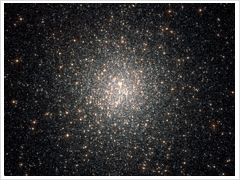 Copyright(c)www.hubblesite.org All Rights Reserved.
Copyright(c)www.hubblesite.org All Rights Reserved.This Hubble telescope image shows the globular cluster NGC 2808. Of the about 150 known globular clusters in our Milky Way Galaxy, NGC 2808 is one of the most massive, containing more than 1 million stars. Far different from smaller cluster stars which are thought to be formed at the same time and in the same place, Hubble's sharp resolution discovered three generations of cluster stars in NGC 2808.
 Copyright(c)www.hubblesite.org All Rights Reserved.
Copyright(c)www.hubblesite.org All Rights Reserved.This image from the Hubble Space Telescope is NGC 3603, which is a complex of a nebula and massive star clusters, about 20,000 light-years away. Powerful ultraviolet radiation and fast winds from the bluest and hottest stars have blown a big bubble around the cluster. These clouds are composed of dense dust and gas and are about 10 to 50 times more massive than the Sun.
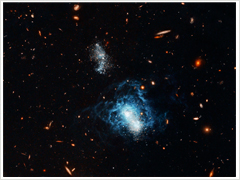 Copyright(c)www.hubblesite.org All Rights Reserved.
Copyright(c)www.hubblesite.org All Rights Reserved.An image of I Zwicky 18 as caught by the Hubble Space Telescope. This galaxy, about 60 million light-years from Earth in the direction of Ursa Major, was previously believed to be a toddler galaxy and was considered a newly born galaxy, but Hubble found faint, older stars within it, suggesting that it may have formed at the same time as most other galaxies.
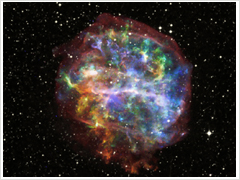 Copyright(c)X-ray: NASA/CXC/Penn State/S.Park et al. All Rights Reserved.
Copyright(c)X-ray: NASA/CXC/Penn State/S.Park et al. All Rights Reserved.This image taken by the NASA Chandra X-ray Observatory shows the debris field of the rapidly expanding supernova remnant G292.0 +1.8. Twenty thousand light-years away, this is one of three supernova remnants in the Milky Way that contain large amounts of oxygen. The debris field contains (along with oxygen) other elements such as neon, silicon and magnesium.
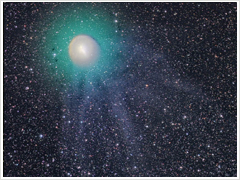 Copyright(c)Mitsunori Tsumura. All Rights Reserved.
Copyright(c)Mitsunori Tsumura. All Rights Reserved.An image of Comet Holmes shot by Mr. Mitsunori Tsuyama, an amateur astronomer from Wakayama Prefecture. The comet's brightness rocketed from the 17th magnitude to the 3rd magnitude between October 24 and 25 and became visible to the naked eye. The great amount of dust and gas makes it look just like an octopus.
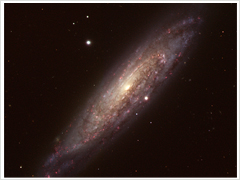 Copyright(c)www.eso.org All Rights Reserved.
Copyright(c)www.eso.org All Rights Reserved.Image of NGC 134, the twisted spiral galaxy, obtained with ESO's Very Large Telescope (VLT). It is located 600 billion light years from earth in the direction of the Sculptor constellation. The spiral arms of the fragile barred structure are thought to be very much like our own Milky Way galaxy, so when seen from far away, our galaxy must certainly look like this.
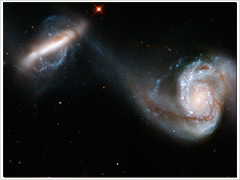 Copyright(c)www.hubblesite.org All Rights Reserved.
Copyright(c)www.hubblesite.org All Rights Reserved.The dynamic form of Arp 87, caught by the Hubble Space Telescope. This pair of galaxies is located 300 million light-years from earth in the direction of the constellation Leo, the Lion. The two galaxies approach each other with gravitational interaction, which distorts their shapes and gives rise to explosive star formation. They will probably merge in the future.
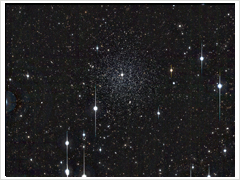 Copyright(c)www.subarutelescope.org All Rights Reserved.
Copyright(c)www.subarutelescope.org All Rights Reserved.An image of the dwarf spheroidal galaxy Leo B (or Leo II) in the constellation of Leo, as caught by the Subaru Telescope. It is a member of the local galaxy group to which our Galaxy belongs. Located 760,000 light-years away from us, each of its stars can be clearly observed. This observation shows that this galaxy has expanded much more than expected.
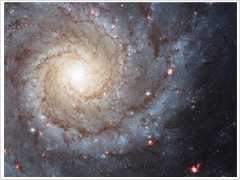 Copyright(c)www.hubblesite.org All Rights Reserved.
Copyright(c)www.hubblesite.org All Rights Reserved.The Hubble Space Telescope image of the nearby spiral galaxy M74. M74 is located roughly 32 million light-years away in the direction of the constellation Pisces, the Fish, and as it is viewed from Earth nearly face-on, its spiral arms are very clearly seen. They are dotted with clusters of glowing pink regions, is where young stars like the Orion Nebula of our Milky Way are being born.
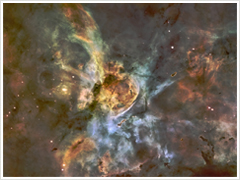 Copyright(c)www.hubblesite.org All Rights Reserved.
Copyright(c)www.hubblesite.org All Rights Reserved.Image of the Carina Nebula region, taken with the Hubble Space Telescope. A mosaic assembled from many frames, the image shows in detail the structure of the large region 7500 light-years distant from us where emission nebula and dark clouds are entangled. At the far left, hidden in dust clouds, is Eta Carinae, one of the most gigantic stars in the solar system. Continuously emitting a great mass of material, it is in the final stages of its lifespan.
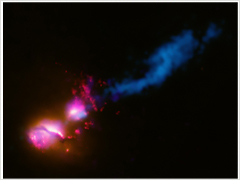 Copyright(c)X-ray: NASA/CXC/CfA/D.Evans et al.
Copyright(c)X-ray: NASA/CXC/CfA/D.Evans et al.All Rights Reserved.
The image of an area of galactic violence called 3C321, located 1.4 billion light years far away in the direction of the constellation Serpens. This composite image shows the jet from a black hole at the center of one of the two galaxies in this system striking the edge of the other galaxy, the first time such an interaction has been found. In the image, data from several wavelengths have been combined. X-rays from Chandra (colored purple), optical and ultraviolet (UV) data from Hubble (red and orange), and radio emissions from the Very Large Array (VLA) and MERLIN (blue) show how the jet from the main galaxy on the lower left is striking its companion galaxy to the upper right.
 Copyright(c)www.eso.org All Rights Reserved.
Copyright(c)www.eso.org All Rights Reserved.The image of the galaxy cluster HCG90, caught by ESO's Very Large Telescope, 8m in diameter. This triplet of galaxies, NGC 7173 (top), 7174 (bottom right) and 7176(bottom left), is located 100 million light-years away towards the constellation of Piscis Austrinus (the 'Southern Fish'). NGC 7174 is a spiral galaxy with a long, twisted tail. This is thought to indicate that the three galaxies are very close and interacting with each other. If you watched the for billions of years, they might look as if they were dancing.
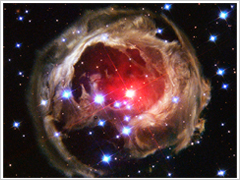 Copyright(c)www.hubblesite.org All Rights Reserved.
Copyright(c)www.hubblesite.org All Rights Reserved.This image is Hubble's view of a nebula around V838 Monocerotis (V838 Mon), a vaiable star in the constellation Monoceros, the Unicorn. Located about 20,000 light-years away from Earth, the star experienced a major outburst caused by the rapid expansion of its outer layers in January 2002, and suddenly brightened for several weeks. The expanding illumination of dust and gas ejected from the star in a previous explosion is called a light echo. Thus this nebula progressively changes in shape and lightness.


